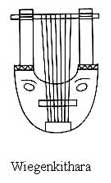.
 
Phorminx (φόρμιγξ) (Similar to the kithara but the arms are straighter and more parallel, and were often elaborately carved, 2) the wooden soundbox of the phorminx has a softer, rounder curve to it, and 3), the soundbox almost always displays unique circle or "eye" designs on its face.) Probably played mainly by women and used as a domestic instrument. After the middle of the 4th century BC not in use. A Phorminx version named by Max Wegener in 1949 the cradle-Kithara (Wiegenkithara) From Diane Touliatos-Miliotis: Homer also refers to the phorminx as bright sounding (ligus) and ornate (daidaleos) in decoration. Homer continues to give us a description of the construction of the instrument by indicating that the instrument's strings were made of sheepgut and that kollopes were used as tuning devices. The kollops over which the string was pulled was a roll of rough leather. It was the roughness which held the string in place at the crossbar. From a Byzantine writer by the name of Eustathius, we know that the kollops was a tuning device made from the hide of the necks of oxen or sheep. Because the ancient Greeks also boiled the sheep and oxen necks for the purpose of making glue, we have the derivation of the word "kolla" (glue). Because of the written descriptions and visual depictions, it can be surmised that the phorminx had a curved outline, a hollow space inside the soundbox, and a round base. Another part of the phorminx was the zugon, which although translates as "yoke", was the crossbar or bridge which joined the two arms of the instrument that could be decorated.



Barbitos (βάρβιτος )(described in the archaic lyric poetry of Alcaeus, Simonides and Sappho. It is a lyre characterized by longer strings and, therefore, a lower pitch. Aristotle says that it is used for pleasure and not for educational purposes. Sappho is shown often playing the Barbitos in Lesbos where it was called barmos "lyre for drinking parties"). Considered an invention of Terpander. Other names: Baromos, Barymiton
Harp

- (See: ) (
Aeolian Harps, named after the Greek God of Wind, 'Aeolus', first appeared in Grecian culture circa 6 BC, when Orpheus, the 'original' poet, held poetry readings accompanied by the music of Wind Harps. Much later, artisans of the Renaissance era re-discovered Aeolian Harps, fascinated with both their physical and etheric properties. Much experimentation with the Aeolian principle, i.e., the vibration of strings by wind, led to a variety of designs and installations as illustrated by these two towers.(circa 1695 AD) )
Enkomion, praise for some person
Epinikion, song for victory athletic or military “A poet, along with his trained band of singers and musicians, would stand by the altar to the victor’s god and offer “prayer, praise, and admonition mingling with the fumes of intoxicating poetry” ( ) (
|